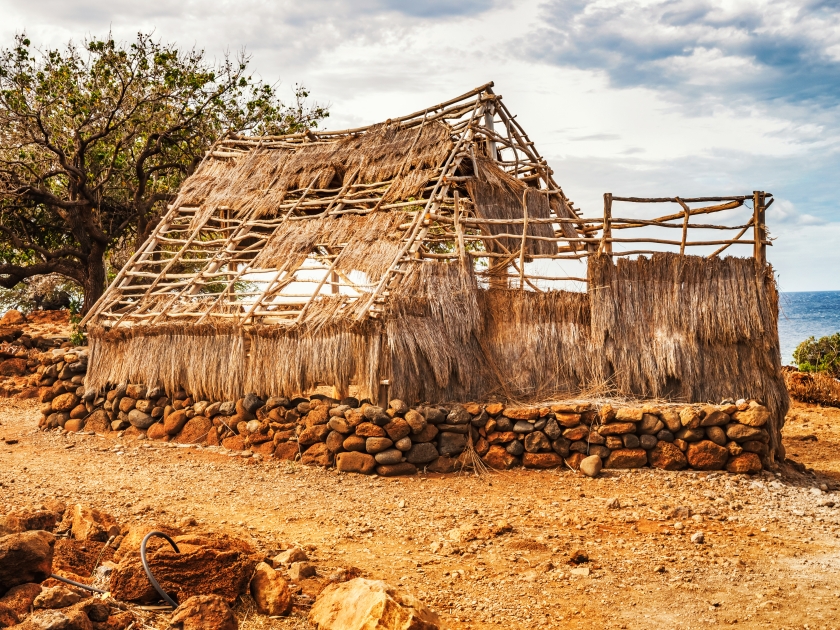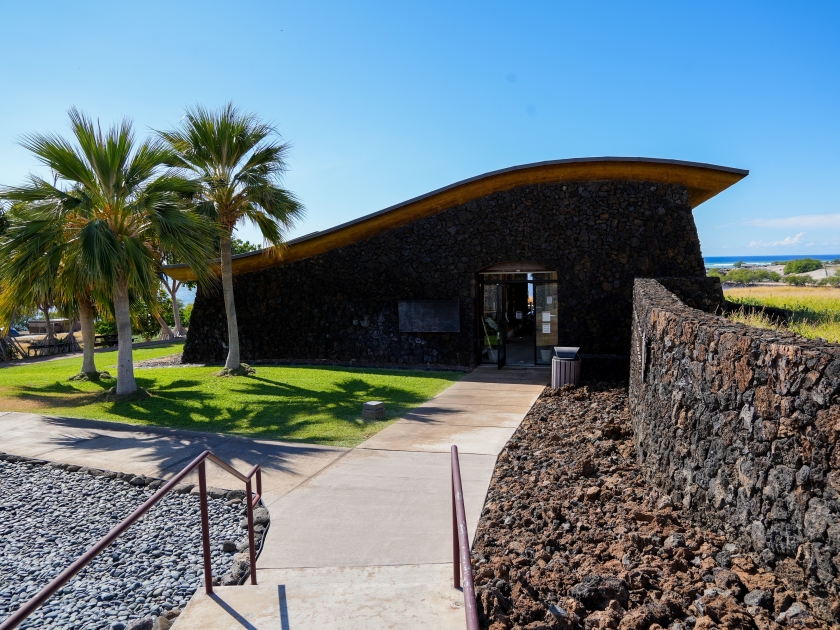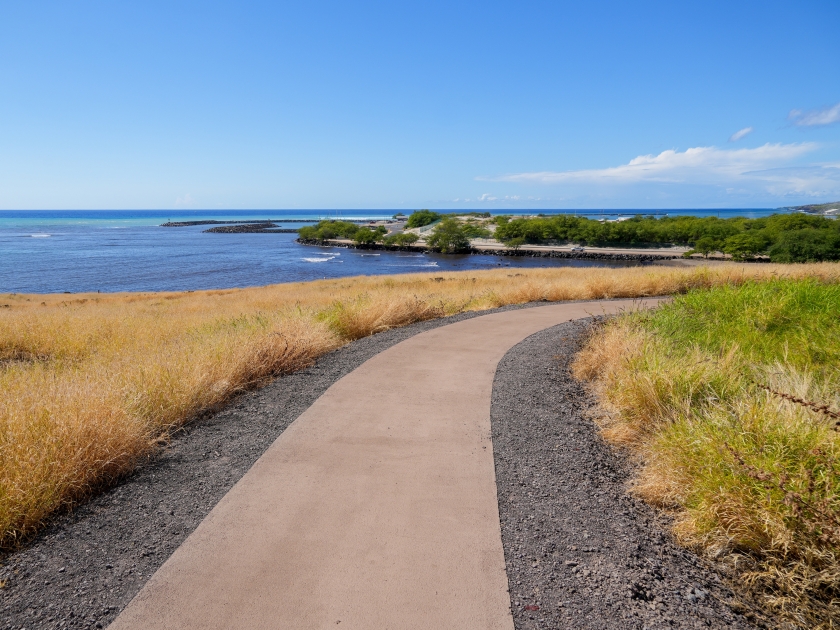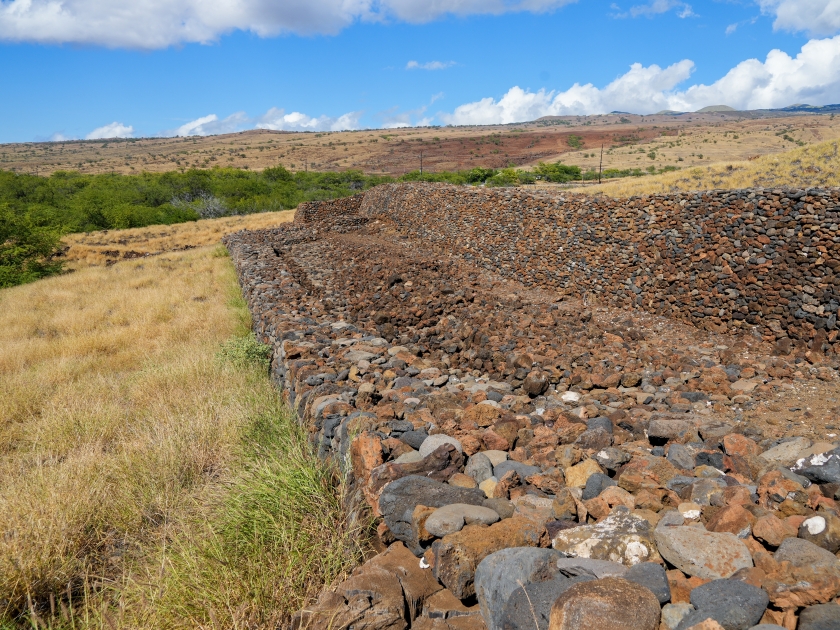Puukohola Heiau, one of Hawaii’s most historically significant landmarks, was built by King Kamehameha I between 1790 and 1791 as a sacred temple dedicated to the war god Kū. Located on the Kohala Coast of the Big Island, this massive stone structure played a pivotal role in Kamehameha’s efforts to unite the Hawaiian Islands. This guide explores its history, cultural significance, and tips for visiting this remarkable site.
Highlights
- The temple is located on a hill overlooking the Kohala Coast, offering visitors panoramic views of the Pacific Ocean. It’s a serene spot for photography and reflection.
- Learn about the ancient Hawaiian culture through guided tours that delve into the temple’s history, the construction process, and its role in Hawaiian spirituality.
- During winter months, visitors can spot humpback whales from the park’s shoreline.
- Explore the area’s native flora, including sacred plants used in traditional Hawaiian rituals.
- The park features a visitor center with educational exhibits, giving visitors deeper insights into the cultural and historical context of the temple.
History

Kamehameha’s Vision of Unification
In the 1790s, Kamehameha I was a rising warrior chief determined to fulfill his prophecy of uniting all the Hawaiian Islands under his rule. To ensure his victory, he was advised by his kahuna (priest) to build a luakini heiau, a temple dedicated to the war god Kūkāʻilimoku. This sacred temple would serve as a place of worship and sacrifices, believed to grant Kamehameha divine favor in his military pursuits.
The Construction of a Sacred Temple
The construction of Puʻukoholā Heiau began in 1790 and was completed in 1791. The temple’s massive stones were transported over 20 miles from Pololū Valley, carried by thousands of workers. Remarkably, the temple was constructed without the use of mortar, yet its walls rise an impressive 16 to 20 feet in height, showcasing the incredible skill and effort that went into its creation.
Rituals and Sacrifices to the Gods
Once completed, Puʻukoholā Heiau became a site of intense religious activity. Various rituals and ceremonies were performed within its walls, many of which involved human sacrifices to appease the gods. These sacrifices were believed to secure victory in battle, ensuring Kamehameha’s dominance over the islands.
A Key to the Unification of Hawaii
The dedication of Puʻukoholā Heiau marked a turning point in Kamehameha’s campaign to unite the Hawaiian Islands. With the spiritual backing of the temple and the favor of Kūkāʻilimoku, Kamehameha eventually succeeded in unifying the islands, forever altering the course of Hawaiian history. Puʻukoholā Heiau stands today as a testament to this pivotal moment in the rise of the Hawaiian kingdom.
Puʻukoholā Heiau as a National Historic Site
In modern times, Puʻukoholā Heiau has been preserved as a National Historic Site, managed by the National Park Service. The site attracts visitors from around the world, offering a chance to walk through history and explore the cultural significance of the heiau. For Native Hawaiians, it remains a deeply sacred place, rich with ancestral importance.
Cultural Events at Puʻukoholā Heiau
Throughout the year, Puʻukoholā Heiau hosts traditional Hawaiian cultural events, including hula performances and ceremonies. These gatherings offer visitors a rare glimpse into the living culture of Hawaii, as well as an opportunity to witness the deep connection between the Hawaiian people and their sacred sites. Puʻukoholā Heiau stands as a symbol of both historical triumph and spiritual reverence, making it a must-visit destination for those interested in Hawaiian culture and history.
What to See at Puukohola Heiau

Heiau Structure
The centerpiece of Puukohola Heiau is its impressive stone temple, which is constructed entirely without mortar and uses lava rocks carefully placed together. This large, rectangular heiau stands as a testament to ancient Hawaiian engineering and devotion. Surrounding the temple are the remains of the Mailekini Heiau and the John Young Homestead, which add to the historical significance of the complex.
Visitor Center
The Puukohola Heiau Visitor Center offers informative exhibits that delve into the heiau’s history and its role in Hawaiian unification. Displays feature artifacts, interpretive panels, and audio-visual presentations that help visitors understand the cultural importance of the site and its connection to King Kamehameha I.
Coastal Views and Landscape
The heiau is perched on the Kohala Coast, offering stunning views of the surrounding landscape and the Pacific Ocean. Visitors can take in the beauty of the windswept coastline, observe the diverse wildlife, and enjoy the peaceful atmosphere while reflecting on the historical significance of the area.
Cultural Significance Today
Today, Puukohola Heiau is part of the Pu’ukohola Heiau National Historic Site, managed by the National Park Service, which works to preserve and protect this sacred landmark. Each year, the site hosts the Hawaiian Cultural Festival, where visitors can immerse themselves in traditional Hawaiian practices, crafts, and music, celebrating the rich cultural heritage of the islands. As the heiau is still considered a sacred space, visitors are encouraged to show respect by observing the site’s guidelines, maintaining quiet reflection, and refraining from disturbing the grounds.
Practical Information for Visitors

Hours and Admission
Puukohola Heiau National Historic Site is open daily from 7:45 AM to 5:00 PM, and admission is free for all visitors. The Visitor Center is also accessible during these hours, providing additional insights and information about the site.
Guided Tours
Visitors can explore Puukohola Heiau through self-guided tours, with informational signs placed around the site for context. Additionally, park rangers are often available to lead guided tours, offering deeper insights into the history and cultural importance of the heiau and surrounding areas.
Tips for Visiting
- Arrive Early: Visit in the morning to avoid the midday heat and larger crowds.
- Wear Sun Protection: Bring sunscreen, a hat, and sunglasses, as the site is exposed to direct sunlight.
- Stay on Marked Paths: Respect the sacred grounds by sticking to designated trails and walkways.
- Bring Water: Stay hydrated, especially during hot weather, as there are limited facilities on-site.
- Attend the Annual Festival: Visit in August to experience the Hawaiian Cultural Festival, offering cultural demonstrations and performances.
- Respect the Sacred Space: Maintain a quiet, respectful demeanor while visiting this culturally significant site.
- Check for Ranger-Led Tours: Enhance your visit by joining a guided tour with a park ranger for more historical context.
Best Time to Visit
The best time to visit Puukohola Heiau is during the morning hours when temperatures are cooler and crowds are minimal. The site is located in a sunny and dry region, so early visits help avoid the afternoon heat. The annual Hawaiian Cultural Festival, usually held in August, is also a prime time to experience the site’s cultural significance.
Nearby Attractions

Nearby Puukohola Heiau, visitors can explore additional historical sites that add to the cultural richness of the area. Mailekini Heiau, located just below Puukohola, was originally built as a temple and later converted into a fort by Kamehameha I. Another notable attraction is the John Young Homestead, the home of Kamehameha’s trusted advisor, which offers insight into life during the unification of the Hawaiian Islands. Both sites enhance the historical experience and provide a deeper understanding of the region’s significance.
Frequently Asked Questions (FAQs)
Puukohola Heiau was constructed to fulfill a prophecy that would help King Kamehameha I unite the Hawaiian Islands under his rule.
Puukohola Heiau is located in the Kohala district on Hawaii’s Big Island, near the town of Kawaihae
Yes, Puukohola Heiau is part of a National Historic Site, and visitors can explore the area through guided and self-guided tours.
Puukohola Heiau played a crucial role in the unification of Hawaii, symbolizing King Kamehameha I’s rise to power and religious devotion.
Puukohola means “Hill of the Whale,” referring to its location overlooking the ocean, where whales are often spotted during the winter months.
Visitors are asked to respect the sacredness of the site by not walking on the heiau and observing all posted rules.
How to Get There
By Car
To reach Puukohola Heiau by car, start your journey from Kailua-Kona. Follow the Queen Ka’ahumanu Highway (Highway 19) northbound for about 40 miles until you reach Kawaihae. Once there, take the exit toward Kawaihae Harbor. Follow the signs for Puukohola Heiau National Historic Site, which will lead you to the entrance located off Spencer Road. The drive offers stunning coastal views and takes approximately an hour.
By Bus
For those opting to travel by bus, start from Kona International Airport. You can take the Hele-On Bus, which operates throughout the Big Island. Board the bus headed for Waimea and transfer to the Kawaihae bus. Disembark at the stop near the harbor, and from there, it is a short walk to Puukohola Heiau National Historic Site. Check the latest bus schedules as they may vary, and prepare for a longer journey compared to driving.
Step Into History’s Footprints
Visiting Puukohola Heiau is more than just a journey to a historic site—it’s a step back in time, where the stones tell the story of Hawaiian unification and cultural strength. This ancient temple, built by the hands of King Kamehameha’s warriors, stands as a powerful reminder of Hawaii’s rich past. Plan your visit today and connect with the enduring legacy of the islands!




